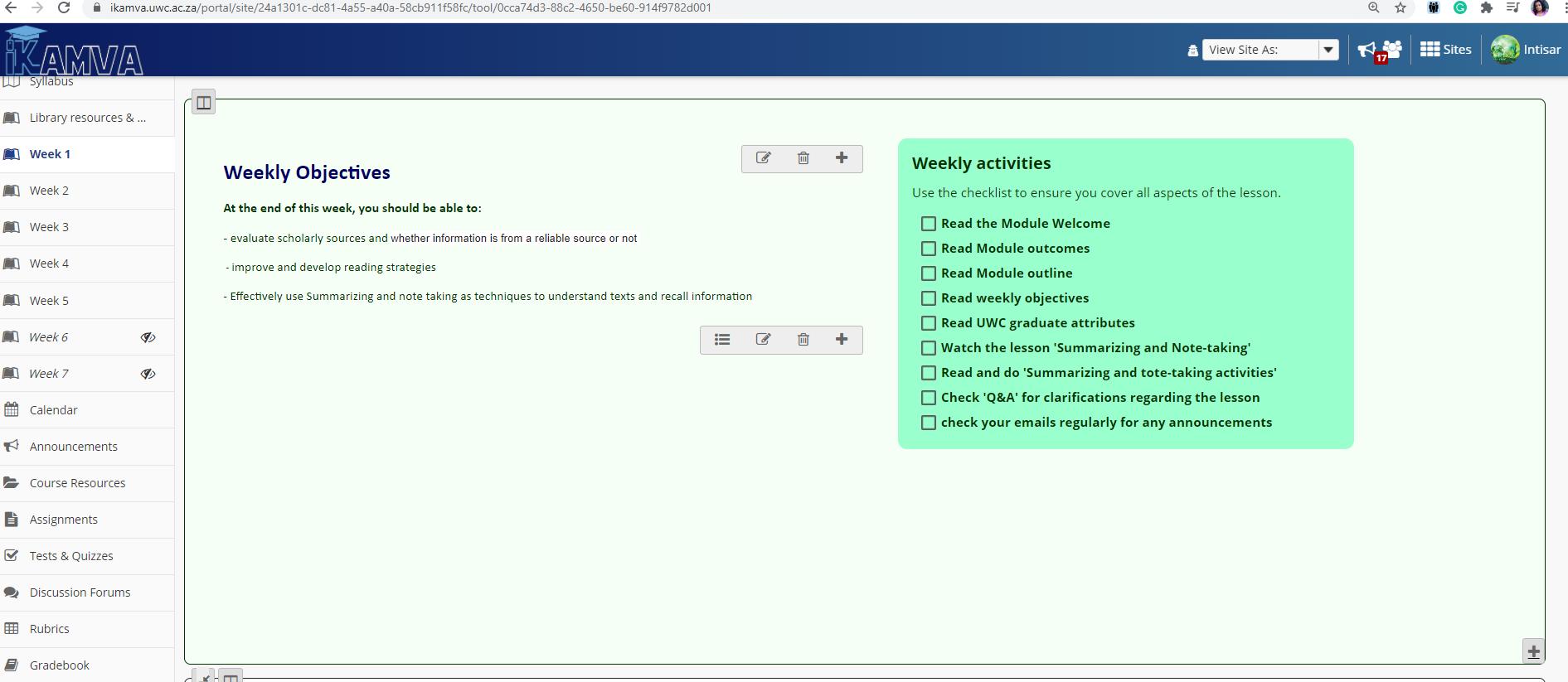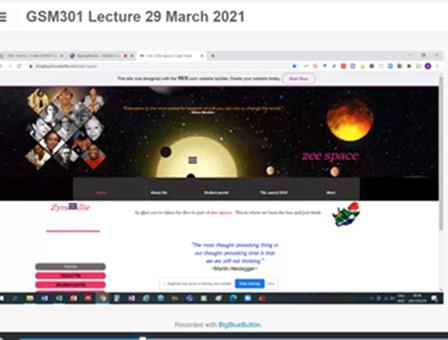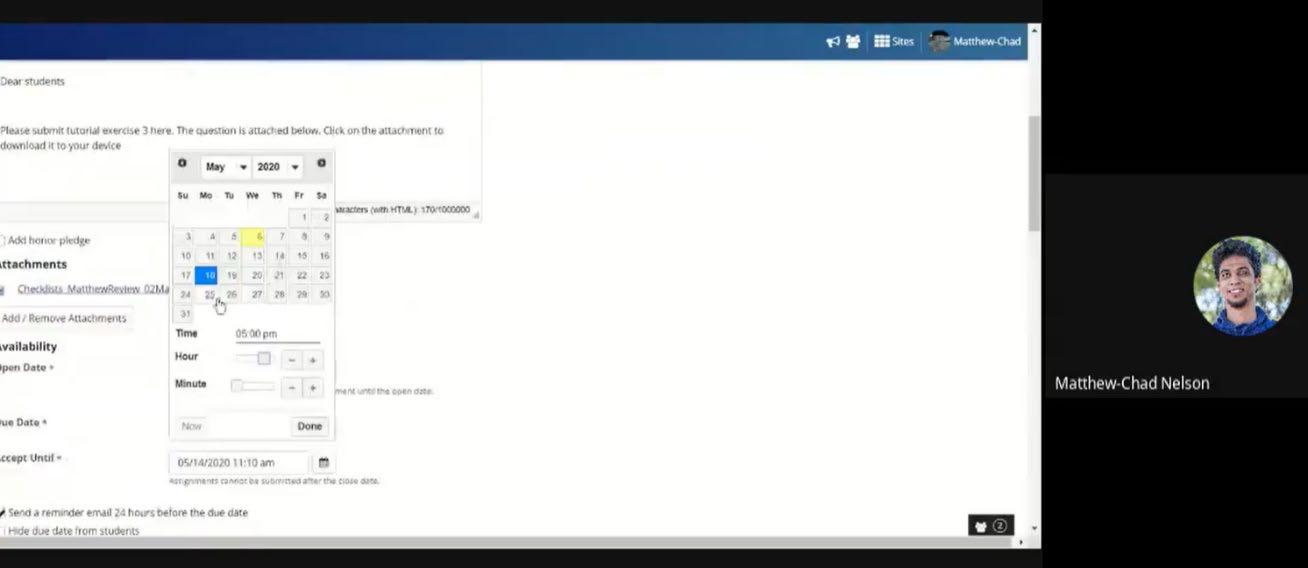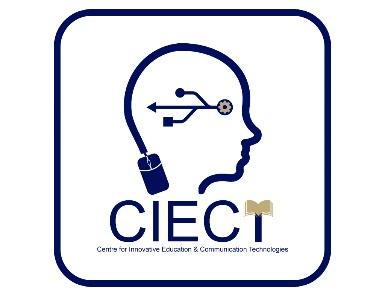
10 minute read
Blended course eTools within iKamva are used by the Education Faculty that focuses on the use of ICTs which enhance teaching and learning practices in the classroom. Read More
2. Value of Pedagogical Learning & Teaching Highlighted
1. The online worksheet tool – the Education Faculty members make use of the online worksheet tool within the eTeaching Platform. The online worksheet is used as an assessment tool. The
CIECT team assists lecturers on how to make use of the online worksheet tool. This allows lecturers to mark the worksheet online; and also allows their students to view their marks and comments online.
2. The online test environment within the iKamva platform – the Department of Educational
Psychology, uses an online module that focuses on teaching ‘Life Orientation’ within the Senior
School Phase. Online tests are set-up in such a way to accommodate various types of questions. These online tests are monitored with invigilation processes in place. Furthermore, course resources are shared – such as assigned readings and lecture slides.
3. The usage of digital storytelling – the Education Faculty uses digital storytelling to create lesson plans to teach languages. A scaffolding approach is used to highlight various concepts in relation to reading and writing skills. The use of Information and Communication Technologies (ICTs) for teaching and learning are promoted within digital storytelling where eSkills are attained and used for broader application, including the creation of posters. The use of digital storytelling designing and development is also used in the foundation phases of teacher education. The teacher’s reflective digital story, focuses on the literacy development during their field work practice. This also includes digital story assessment tasks that develops critical thinking skills, pedagogical approaches, problem solving; and scaffolding interventions such as listening, speaking, reading and writing skills.
4. Blended course eTools within iKamva are used by the Education Faculty that focuses on the use of ICTs which enhance teaching and learning practices in the classroom. The objectives and aims are supplemented by lecturer who incorporate blended approaches by making use of various eTools within the iKamva platform. The Lessons eTool, and tasks are clearly planned, designed and scaffolded with various components that are aligned. These components are linked to student tasks, group discussions, practical sessions and websites. In addition, the discussion forum eTool is used to discuss a specific topic; enabling students to engage with
their peers. The discussion forum eTool enables formal and informal learning to gain valuable learning experiences in different social settings. The assignments eTool is used for the purpose of “distributing and collecting” homework tasks, assignments and the final examination. Students are expected to complete tasks, assignments and examinations. Formative and summative assessment tasks are hosted within iKamva (that serves as a repository); allowing lecturers to mark tasks online and offline. Students submit tasks regardless of space or time, which is an important aspect of a blended teaching and learning approach.
5. A student peer-review eTool is used to develop the academic writing by education students.
The peer-review eTool is featured within the Turnitin (Tii) platform which randomly assigns submitted pieces to students for per review. The peer review eTool has the following specific pedagogical value and functionalities: A student can only do a peer-review, if the student submitted a written piece; a student who has peer-reviewed a piece, automatically attains a mark towards their Continuous Assessment Mark (CAM). The pedagogical value of the peer review eTool helps develop academic writing and genders experiences on how to do constructive peer-reviews; and alternatively, it genders self-directed learning. The peer review eTool teaches students to engage within the online environment, viz., the Tii platform.
6. The Education Faculty specifically designs blended teaching-and-learning online environments for academic writing with content that is enhanced and supported by digital media components. This online environment incorporates the pedagogical and design aspects of blended teaching and learning aspects such as podcasts and videos. The digital media components support different learning styles. Students engage with text, audio and video in order to effectively contribute to discussion forums and reflective quizzes. This blended learning environment ensure students engage with the content related to their face-to-face lectures. In preparation for examination, face-to-face lectures, online environment and eAssessments is used. Face-to-face lectures is used to engage with specific topics within the iKamva platform. Online lecture presentations are shared with students prior to attending face-to-face sessions. This design allows students to read and prepare in order to actively engage during the face-to-face lectures. The eAssessment tool can be used to supplement
the face-to face and online activities. In addition, the tests & quiz eTool is used to structure online term tests.
Structured, Interactive Online Environment’
7. eTools that support reflective learning and teaching practices within the Education Faculty –this online environment created within iKamva employs a rigorous methodology of reflective practice, supported by the use of online lessons, discussion forums, assignments and course resources. The reflective learning eTool is directly linked to the assessment criteria for formative and summative purposes; including theory essays, reflective practice assignments and relevant practicals. Lecture modules content are explored through a variety of digital media components such as videos, PowerPoint presentations, articles and online discussions. In addition, online reflective & assessment spaces are utilized to help students explain and elaborate on their understanding of content through online discussions and submission of assignments that allows for evaluation and student progress.
8. The Educations Faculty’s fully online programme is designed in such a way that it facilitates around the effective use of eTools to support learning and teaching practices, instructional design, facilitation, content development and online support. These include: student orientation from various geographical environments; student engagement, reflection and assessment programmes which employs a rigorous methodology of reflective practice,
supported by the use of online lessons, discussion forums, assignments and course resources. Furthermore, the eTools are directly linked to the assessment criteria for formative and summative purposes. Structured online lessons are explored through a variety of digital media components such as videos, PowerPoint presentations, articles, online discussions, and livevideo conferencing functionality within iKamva (BigBlueButton).
9. ‘Flipped Classroom’ approach in teaching-and-learning online environments – The Education
Faculty makes use of the ‘Flipped Classroom’ approach conducted in three (3) phases: pre, during, and post- lecture These phases are administered in an online environment created within the iKamva platform. Students receive PowerPoint lecture slides or notes, videos and other multimedia course material to engage with before the lecture. During the lecture, the students’ understanding is deepened through activities such as material developments, problem-solving, presentations, role play, inquiry-based learning, and simulations. After the lecture, students engage in scenario-based activities.
10. The Education Faculty designed an application, viz., the ‘take-home’ research proposal aligned to rubric – A online ‘take-home’ assessment is set up whereby students submit research proposals. Lecturers share a rubric with their students which entail the assessment criteria. The assessment is set-up using the ‘iKamva-Turnitin integration’, and students are given sufficient time in order to submit and edit accordingly for re-submission purposes.
11. The Education Faculty’s announcement eTool on the iKamva platform – This announcement eTool allows lecturers to communicate important information to students regarding coursework and other related matters. Lecturers post a variety of messages to the students on the iKamva platform, which is sent to their student email inbox. Announcements include the following:
Student opportunities to earn formal credits, funding regarding the opportunities, scheduled test, venues and times, and cancellation of lectures. In addition, Google Forms (embedded within the
Announcement eTool) are used to complete forms or surveys, which informs the lecturer on how to adjust teaching style in order to accommodate the needs of the students.

Multimodal Approach: Use of online conferencing/ meeting tool for ‘live lectures
3. Student-centric online environments
In response to the national lockdown, the Education Faculty assisted students by using a multimodal approach. Lecturers make use of social learning via WhatsApp and iKamva to support their students. This format of learning embraces the #NoStudentWillBeLeftBehind campaign. Meeting times are scheduled and information is shared with students regarding their challenges with connectivity such as struggling with the uploading of their assignments to iKamva. These challenges are shared via WhatsApp groups allowing the lecturer or group coordinators to upload remedies via the Assignment eTool. This is a collaborative effort (Multimodal approach) between the lecturer, teaching assistants, tutors and the CIECT Instructional Design Team.
The multimodal approach entails a structured online environment to allow for (1) announcements that are posted on iKamva and also shared on the WhatsApp group, (2) structured course resources aligned to content topics are shared including multimedia, (3) continuous assessment tasks including term assessment that are structured within the Assignment eTool, (4) and for test & quizzes that tests application and attained knowledge.
The Education Faculty lecturers utilises the iKamva platform in order to support student-educators. This they do by using chat rooms, live lectures, break-away rooms & student opinion pieces. This environment incorporates various content, communication, and assessment tools to support teaching and learning during the national lockdown period. The ‘Chat room’ is the informal discussion space to address student challenges and respond to various topics set up by the lecturer. Students use this space as a platform to discuss course work, concerns regarding teaching during the pandemic, and other related issues. Lecturers also make use of live lectures and group discussions via the BigBlueButton. In addition, the discussion forum is used as an assessment tool, especially formative. Topics are created, and students post their opinion pieces in the forum; and comment on one another’s opinions; either to agree or disagree and substantiate accordingly. This type of assessment allows student-educators to reflect deeply about the teaching profession and the challenges.

Discussion Forum: Asynchronous communication and reflection
Furthermore, in response to the national lockdown, the Education Faculty continued with blended learning provisions, planning, design, and development, including:
The design of structured interactive online environments: Lecturers create structured online environments providing students with relevant interactive learning material such as videos, PowerPoint presentations, articles and documents. The ‘Lessons eTool’ presents content in an interactive manner by embedding presentations, videos, and other learning material.
The design of an online reading corner: An ‘online reading corner’ was created, which was aimed at motivating students to read different literature pieces and share their feedback within the discussion forum.
Online meetings designed for students: Lecturers engage in online meetings with their students, using various online meeting applications (BBB, Zoom & Google Meet).
Weekly Assessment Activities are designed for students to engage in weekly tasks, which are designed within the tests & quizzes eTool. These tasks include the use of various question types such as True-and-False, Short Answer and Multiple-Choice Questions (MCQs). Formative tasks are used as a form of consolidation of course content; and also, a space for reflection and goal setting. In addition, these tasks assist with reinforcement, revision and preparation for examinations as well as the future careers of educators.
The completion of course evaluations: Students are required to complete evaluations (surveys shared via iKamva) – which provide feedback to lecturers around teaching and learning approaches; and student’s learning and progress.
The design of group assignments and structured reflective assessment tasks: Lecturers within the Language and Education Department created structured online environments for undergraduate and postgraduate students. Various individual and group assessment tasks are created. The students are expected to join a specific group, contribute to the group sessions; submit group assignments; as well as individual reflective pieces.
The use of WhatsApp for assessment purposes to supplement the online environment: Students create WhatsApp recordings/podcasts (oral assessment task) aligned to specific topics. The reflective oral tasks are uploaded via the ‘Assignments eTool’ within iKamva.
Concluding Remarks
This first issue highlighted the pedagogical value of using emerging technologies to make learning more meaningful within the Education Faculty. Furthermore, the issue reflects on efforts by the faculty prior to the pandemic (national lockdown); and during 2020. The CIECT team will continue to showcase the collaboration with Faculties; and especially in relation to the effective student-centric design and development of online environments.
We welcome collaboration with academics across disciplines and look forward to contributions for the upcoming BLAST Issues.
Send contributions to:
Dr Paul Dankers: pdankers@uwc.ac.za
Dr Juliet Stoltenkamp: jstoltenkamp@uwc.ac.za

Tutorial Exercise: Use of Synchronous eTools (supports Asynchronous teaching)
Contact us via
Website: https://ikamva.uwc.ac.za Email: elearning@uwc.ac.za
Social Media
@CIECT @CIECT @CIECT http://ciect.wordpress.com




